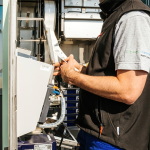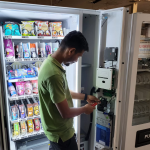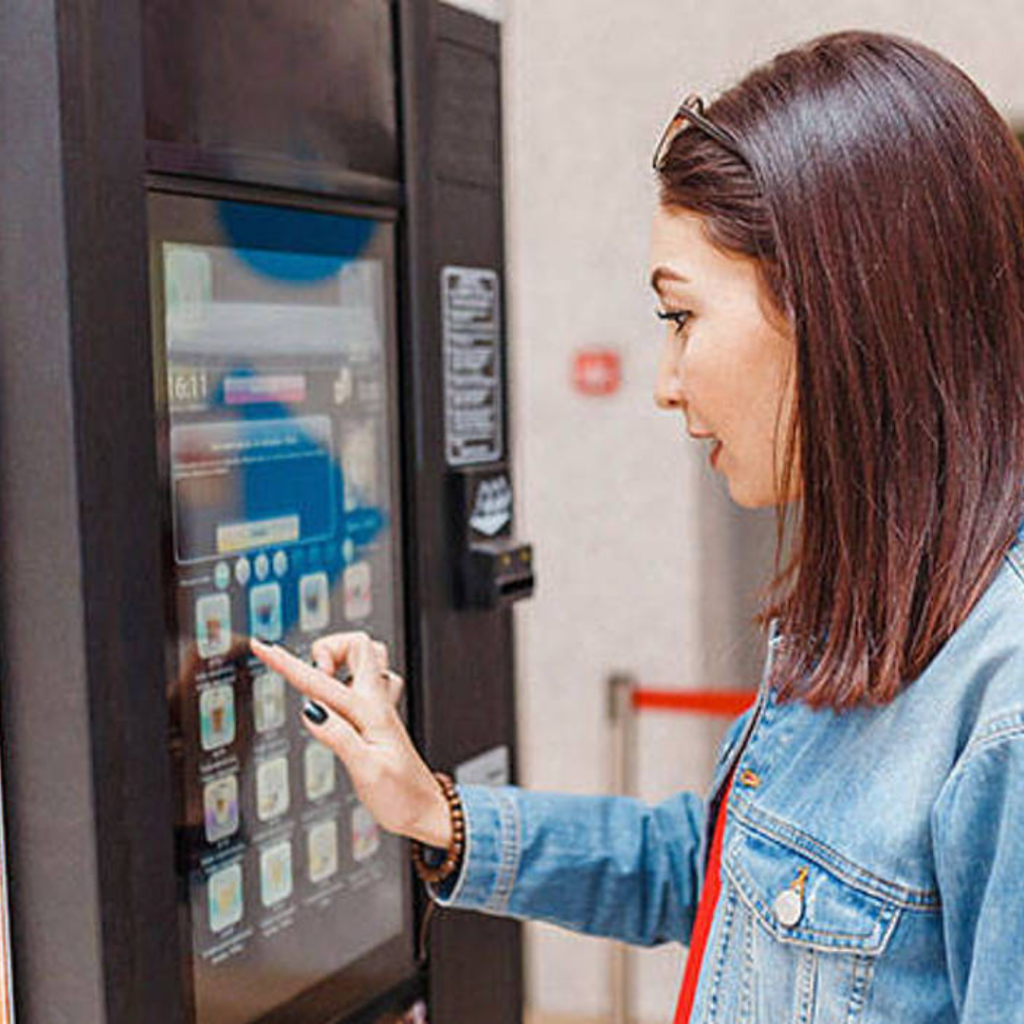Export ready American built machines in stock, shipping from Miami
Vending Machine Size and Dimension Guide: Choosing the Right Fit for Your Location

Vending machines are no longer just a convenient way to grab a snack—they’ve evolved into essential fixtures in offices, schools, gyms, and retail spaces. But before investing in a vending machine, it’s crucial to consider one of the most important factors: size and dimensions.
Choosing the wrong size vending machine can lead to wasted space, inefficient placement, and poor customer experience. On the flip side, selecting the perfect machine ensures smooth operations, optimal customer satisfaction, and maximized revenue potential. This guide will help you understand vending machine size, key considerations for your location, and tips for making the best choice.
Why Size Matters in Vending Machines
The size of your vending machine impacts every aspect of its functionality and success. Here’s why it’s so important:
- Space Efficiency: The dimensions of your vending machine must fit seamlessly into your location without obstructing foot traffic or violating accessibility requirements.
- Product Capacity: Larger machines can hold more inventory, which reduces the frequency of restocking but may not be practical for smaller spaces.
- Customer Experience: A vending machine that’s too small might not meet demand, while an oversized machine might look out of place.
- Compliance and Regulations: Some locations, like schools or public spaces, require vending machines to comply with specific size and placement guidelines for accessibility.
Standard Vending Machine Sizes
Vending machines come in various sizes to cater to different needs. Here are the most common categories, including insights into pop machine dimensions and weights.
1. Full-Size Vending Machines
Dimensions:
- Height: 72–75 inches
- Width: 29–40 inches
- Depth: 30–35 inches
Weight:
- Full-size vending machines weigh between 400–900 pounds, depending on their materials and features.
Capacity:
- Full-size vending machines can hold up to 300–500 products, depending on the machine’s configuration (snacks, beverages, or a combination).
Ideal Locations:
- High-traffic areas like airports, schools, malls, or office buildings.
Benefits:
- High capacity minimizes restocking frequency.
- Wide variety of product options.
Considerations:
- Requires ample space and easy access for installation and maintenance.
2. Soda Machines (Pop Machines)
Soda machines, or pop machines, are designed specifically for beverages and come in slightly different dimensions compared to snack or combination vending machines.
Dimensions:
- Height: 72–76 inches
- Width: 30–40 inches
- Depth: 30–36 inches
Weight:
- How much does a soda machine weigh? Soda machines typically weigh 500–800 pounds, depending on the model and features.
Capacity:
- These machines can hold up to 400 cans or bottles, depending on size and configuration.
Ideal Locations:
- Schools, gyms, offices, and retail spaces.
Benefits:
- Specifically designed for beverages.
- High durability and consistent cooling performance.
Considerations:
- Requires power outlets and regular maintenance for cooling systems.
3. Compact or Slimline Vending Machines
Dimensions:
- Height: 54–65 inches
- Width: 22–28 inches
- Depth: 20–24 inches
Weight:
- Compact machines typically weigh around 250–400 pounds.
Capacity:
- Compact machines typically hold 100–250 items, making them suitable for smaller locations.
Ideal Locations:
- Small offices, gyms, or boutique retail stores where space is limited.
Benefits:
- Space-saving design.
- Easier to install and transport.
Considerations:
- Limited product capacity may require frequent restocking.
4. Specialty Vending Machines
Specialty vending machines are tailored for specific products like coffee, ice cream, or electronics, so their dimensions can vary significantly.
Examples:
- Coffee vending machines are typically around 60 inches tall and 24 inches wide.
- Ice cream vending machines can be 70 inches tall and 30 inches wide.
Weight:
- Depending on the product type, specialty machines weigh between 300–600 pounds.
Ideal Locations:
- Specialty shops, break rooms, or event venues.
Benefits:
- Customization for niche markets.
- Adds novelty and uniqueness to your location.
Considerations:
- May require additional maintenance due to specialized components.
5. Wall-Mounted Vending Machines
Dimensions:
- Height: 25–36 inches
- Width: 18–24 inches
- Depth: 8–12 inches
Weight:
- Wall-mounted vending machines are lightweight, typically around 50–100 pounds.
Capacity:
- Holds smaller quantities, typically 20–50 items.
Ideal Locations:
- Bathrooms, dorm rooms, or small office spaces.
Benefits:
- Compact and space-efficient.
- Easy to install and ideal for locations with no floor space.
Considerations:
- Limited capacity and product variety.
How Much Does a Vending Machine Weigh?
The weight of a vending machine varies depending on its size, type, and features. Here’s a breakdown:
- Full-Size Vending Machines
- These larger machines, commonly used for snacks and beverages, weigh between 400–900 pounds.
- Factors like the type of material (e.g., steel vs. lightweight aluminum), built-in refrigeration units, and inventory capacity can affect their weight.
- Soda Machines (Pop Machines)
- How much does a soda machine weigh? Soda vending machines typically weigh between 500–800 pounds, as they require heavy-duty cooling systems to keep beverages chilled.
- Compact or Slimline Machines
- These smaller, space-saving vending machines weigh around 250–400 pounds. Their reduced weight makes them easier to transport and install, making them ideal for smaller locations.
- Specialty Vending Machines
- Specialty machines, like coffee or ice cream vending machines, weigh between 300–600 pounds, depending on their specific components (e.g., freezers or brewing units).
- Wall-Mounted Vending Machines
- The lightest option, wall-mounted vending machines weigh between 50–100 pounds. Their compact design makes them perfect for tight spaces like restrooms or dormitories.
How to Measure Your Space for a Vending Machine
Before purchasing a vending machine, it’s essential to measure your space accurately to avoid installation issues. Here’s a step-by-step guide:
1. Measure the Available Area
- Width: Ensure there’s enough room to accommodate the vending machine and allow for clearance on both sides (at least 2–3 inches).
- Height: Account for ceiling height and any overhead fixtures.
- Depth: Make sure there’s sufficient depth for the machine, plus extra space for customers to stand comfortably in front of it.
2. Consider Doorways and Pathways
- If you’re wondering how much does a vending machine weigh, it’s important to ensure that all entry points, including doors, hallways, and elevators, can accommodate the machine’s size and weight during delivery.
3. Allow for Maintenance Access
- Leave enough space behind and around the machine for servicing, restocking, and ventilation.
4. Accessibility Requirements
- In public locations, vending machines must comply with ADA (Americans with Disabilities Act) guidelines. This means controls should be reachable from a wheelchair, and the machine should not obstruct pathways.
Matching Vending Machine Size to Location Type
Different locations have unique needs when it comes to vending machine size. Here’s a breakdown:
1. Office Spaces
- Recommended Size: Compact or slimline machines.
- Why: Offices typically have limited space but steady demand for snacks and beverages.
2. Schools and Universities
- Recommended Size: Full-size machines.
- Why: High foot traffic and diverse product needs (healthy snacks, drinks, and specialty items).
- Compliance Note: Ensure the machine adheres to school nutrition standards and accessibility regulations.
3. Gyms and Fitness Centers
- Recommended Size: Compact machines or specialty machines (e.g., protein shakes or healthy snacks).
- Why: Fitness centers often focus on healthier options, and space is typically limited.
4. Retail Stores and Malls
- Recommended Size: Full-size or specialty machines.
- Why: High demand for variety and convenience. Specialty machines (like electronics or skincare products) can enhance customer experience.
5. Events and Venues
- Recommended Size: Portable or compact machines.
- Why: Temporary locations require easy installation and transportation.
Of course, size and dimensions are only part of the equation — the real success of your vending machine depends on where it’s placed. That’s why we offer a vending machine placement service that connects operators with property owners who want the benefits of having a machine on-site without needing to purchase one themselves. This ensures that your full-size, compact, or specialty machine isn’t just the right physical fit, but also in the right location to generate steady revenue. By matching machine type with high-traffic, demand-driven environments, we take the guesswork out of placement and help both operators and businesses succeed.
Conclusion
Choosing the right vending machine is about more than just understanding vending machine size—it’s about balancing dimensions, weight, and functionality with the specific needs of your space and customers. Whether you’re looking at pop machine dimensions, considering how much a soda machine weighs, or planning for a compact solution, understanding the details ensures a smooth installation and long-term success.
By carefully measuring your space, understanding your audience, and aligning your machine’s size with your business goals, you’ll maximize efficiency and customer satisfaction while minimizing potential headaches. A well-chosen vending machine isn’t just a purchase—it’s an investment in convenience, profitability, and customer delight.













